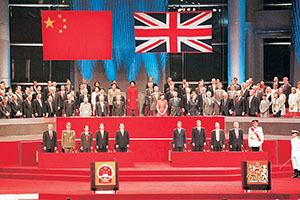
History-Periods
Past eras

From pre-history to today
Choose your period

Periods of History
explore the different eras

Margaret Thatcher, who served as the Prime Minister of the United Kingdom from 1979 to 1990, played a significant role in the lead-up to the negotiation and signing of the Sino-British Joint Declaration. Her position and actions were influenced by various factors, including the Falklands War and her conservative ideology.
Falklands War and Impact:
The Falklands War, which took place between April and June 1982, was a key event that influenced Thatcher's position in the negotiations with China. The conflict erupted when Argentina invaded the Falkland Islands, a British overseas territory in the South Atlantic. Thatcher's firm and resolute response to the invasion, including the successful military operation to retake the islands, bolstered her political standing and strengthened her resolve in international negotiations.
Commitment to the People of Hong Kong:
Thatcher expressed a deep concern for the people of Hong Kong and their future. She emphasized the importance of protecting their interests and securing a favorable outcome for the territory during the negotiations. Thatcher was determined to ensure the preservation of Hong Kong's economic prosperity and way of life.
Negotiating the Joint Declaration:
Thatcher's government began negotiations with China in the early 1980s. While the Falklands War showcased Britain's military strength and enhanced its negotiating position, it also prompted a degree of wariness among some officials in China. Consequently, Thatcher sought to balance her firm stance on Hong Kong's future with a diplomatic approach that would address China's concerns.
"One Country, Two Systems":
Thatcher supported the concept of "one country, two systems" as the basis for the future relationship between Hong Kong and China. She believed this principle would provide the necessary safeguards for Hong Kong's autonomy, legal system, and economic structure. It aligned with her belief in free-market capitalism and her desire to ensure Hong Kong's continued economic success.
The Sino-British Joint Declaration, signed on December 19, 1984, between the United Kingdom and the People's Republic of China, was a pivotal agreement that set the stage for the transfer of sovereignty over Hong Kong from British to Chinese control. The declaration aimed to ensure a smooth transition and maintain the stability and prosperity of Hong Kong under the principle of "one country, two systems."
Here's how the Sino-British Joint Declaration came about and the key elements it outlined:
Negotiations and Historical Context:
In the early 1980s, negotiations between the UK and China regarding the future of Hong Kong gained momentum. The British government realized that the lease of the New Territories, which constituted the majority of Hong Kong's land, was set to expire in 1997. To address this, talks were initiated to determine the post-1997 status of Hong Kong.
Principle of "One Country, Two Systems":
The Sino-British Joint Declaration introduced the concept of "one country, two systems." Under this principle, Hong Kong would become a Special Administrative Region (SAR) of China, enjoying a high degree of autonomy, except in foreign and defense affairs. This meant that while Hong Kong would be part of China, it would maintain its own legal system, economic system, and civil liberties, distinct from mainland China, for 50 years after the handover.
Autonomy and Way of Life:
The declaration guaranteed that the social and economic systems in Hong Kong, including its capitalist system and way of life, would remain unchanged for 50 years after the handover. This commitment aimed to reassure the people of Hong Kong and the international community that the city's unique characteristics would be preserved.
Basic Law:
The Basic Law of the Hong Kong Special Administrative Region, a mini-constitution, was established as part of the Sino-British Joint Declaration. It served as the legal framework for the governance of Hong Kong after the handover. The Basic Law outlined the structure of the SAR government, the protection of rights and freedoms, and the relationship between the central government of China and the SAR.
Joint Liaison Group:
To facilitate the implementation of the Sino-British Joint Declaration, a Joint Liaison Group (JLG) was established. The JLG consisted of representatives from both the British and Chinese governments and was responsible for overseeing the transition process, discussing important matters, and resolving any issues that arose.
The Sino-British Joint Declaration played a critical role in ensuring a peaceful and orderly transfer of sovereignty over Hong Kong from the UK to China. However, the interpretation and implementation of the agreement have been subjects of ongoing debate, particularly in recent years, as concerns over Hong Kong's autonomy and the preservation of its unique identity have surfaced.
The history of Hong Kong is a fascinating tale of colonialism, trade, and transformation. Let's delve into its story, starting from the time when the British took possession of the territory.
British Acquisition:
In 1839, the First Opium War erupted between the British Empire and the Qing Dynasty of China. The war was primarily fought over trade disputes and China's restrictive policies on British imports, particularly opium. The conflict concluded with the signing of the Treaty of Nanjing in 1842. As part of the treaty, Hong Kong Island was ceded to the British Crown.
Early Development:
After taking possession of Hong Kong Island, the British recognized its strategic location and potential as a trading port. They established a settlement and constructed a military fort, which eventually grew into the city of Victoria (now known as Central). Initially, the economy revolved around trade, particularly the lucrative opium trade, which expanded following the Second Opium War (1856-1860).
Expanding Territory:
In 1860, the British acquired the Kowloon Peninsula through the Convention of Peking, which was another outcome of the Second Opium War. The acquisition of Kowloon significantly increased the territory under British control.
Lease of the New Territories:
In 1898, the British and Chinese governments signed the Convention for the Extension of Hong Kong Territory. This agreement leased the New Territories, an area encompassing a significant portion of the mainland, to the British for 99 years. This lease was set to expire in 1997.
Development and Transformation:
Throughout the colonial era, Hong Kong experienced rapid economic development and urbanization. The British implemented various infrastructure projects, including the construction of roads, railways, and a deep-water harbor, which transformed Hong Kong into a major international port and trading hub.
World War II and Japanese Occupation:
During World War II, Hong Kong was occupied by the Japanese from 1941 to 1945. The occupation was characterized by significant hardships and human suffering. After the war, Hong Kong returned to British control.
Economic Boom:
In the post-war period, Hong Kong experienced a remarkable economic boom. It emerged as an important financial center and a manufacturing hub, attracting investment and businesses from around the world. The city's laissez-faire economic policies, low taxes, and business-friendly environment contributed to its rapid growth.
Return to Chinese Sovereignty:
In 1984, the British and Chinese governments signed the Sino-British Joint Declaration, which outlined the terms of the transfer of sovereignty over Hong Kong. The agreement paved the way for the return of Hong Kong to Chinese control on July 1, 1997, under the principle of "one country, two systems." This arrangement granted Hong Kong a high degree of autonomy and allowed its capitalist system and way of life to continue unchanged for 50 years.
If you have a suggestion regarding additional topics you would like to see included - please let us know
Reference: Article by Greg Scott (Staff Historian), 2024
Tour Reviews
History Attractions
Submit Tour Suggestions
2024 Departures
Spotlight Tours
Events and anniversaries

All content and images are protected by copyright to Access History